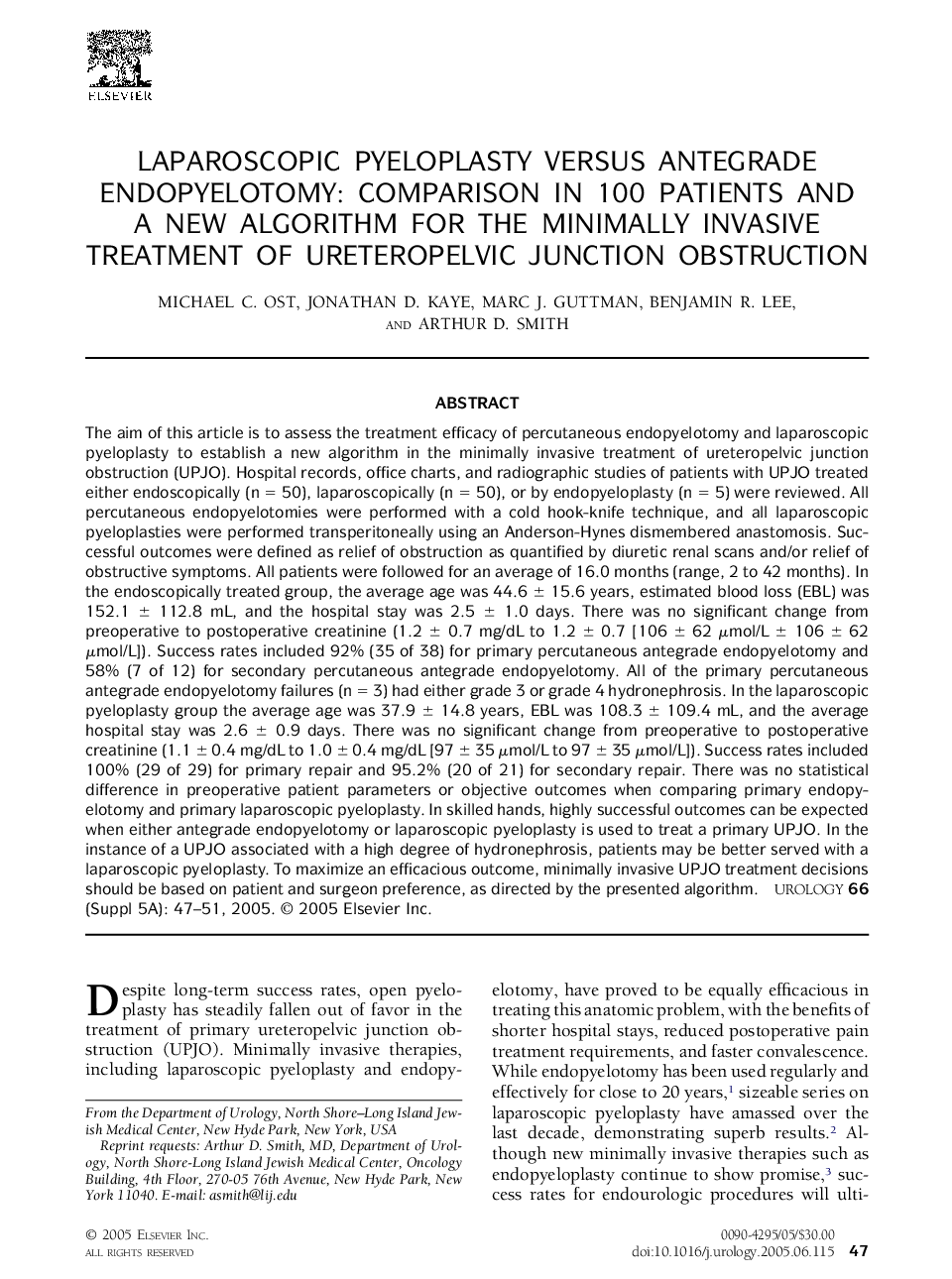| کد مقاله | کد نشریه | سال انتشار | مقاله انگلیسی | نسخه تمام متن |
|---|---|---|---|---|
| 9312952 | 1250465 | 2005 | 5 صفحه PDF | دانلود رایگان |
عنوان انگلیسی مقاله ISI
Laparoscopic pyeloplasty versus antegrade endopyelotomy: Comparison in 100 patients and a new algorithm for the minimally invasive treatment of ureteropelvic junction obstruction
دانلود مقاله + سفارش ترجمه
دانلود مقاله ISI انگلیسی
رایگان برای ایرانیان
موضوعات مرتبط
علوم پزشکی و سلامت
پزشکی و دندانپزشکی
بیماریهای کلیوی
پیش نمایش صفحه اول مقاله

چکیده انگلیسی
The aim of this article is to assess the treatment efficacy of percutaneous endopyelotomy and laparoscopic pyeloplasty to establish a new algorithm in the minimally invasive treatment of ureteropelvic junction obstruction (UPJO). Hospital records, office charts, and radiographic studies of patients with UPJO treated either endoscopically (n = 50), laparoscopically (n = 50), or by endopyeloplasty (n = 5) were reviewed. All percutaneous endopyelotomies were performed with a cold hook-knife technique, and all laparoscopic pyeloplasties were performed transperitoneally using an Anderson-Hynes dismembered anastomosis. Successful outcomes were defined as relief of obstruction as quantified by diuretic renal scans and/or relief of obstructive symptoms. All patients were followed for an average of 16.0 months (range, 2 to 42 months). In the endoscopically treated group, the average age was 44.6 ± 15.6 years, estimated blood loss (EBL) was 152.1 ± 112.8 mL, and the hospital stay was 2.5 ± 1.0 days. There was no significant change from preoperative to postoperative creatinine (1.2 ± 0.7 mg/dL to 1.2 ± 0.7 [106 ± 62 μmol/L ± 106 ± 62 μmol/L]). Success rates included 92% (35 of 38) for primary percutaneous antegrade endopyelotomy and 58% (7 of 12) for secondary percutaneous antegrade endopyelotomy. All of the primary percutaneous antegrade endopyelotomy failures (n = 3) had either grade 3 or grade 4 hydronephrosis. In the laparoscopic pyeloplasty group the average age was 37.9 ± 14.8 years, EBL was 108.3 ± 109.4 mL, and the average hospital stay was 2.6 ± 0.9 days. There was no significant change from preoperative to postoperative creatinine (1.1 ± 0.4 mg/dL to 1.0 ± 0.4 mg/dL [97 ± 35 μmol/L to 97 ± 35 μmol/L]). Success rates included 100% (29 of 29) for primary repair and 95.2% (20 of 21) for secondary repair. There was no statistical difference in preoperative patient parameters or objective outcomes when comparing primary endopyelotomy and primary laparoscopic pyeloplasty. In skilled hands, highly successful outcomes can be expected when either antegrade endopyelotomy or laparoscopic pyeloplasty is used to treat a primary UPJO. In the instance of a UPJO associated with a high degree of hydronephrosis, patients may be better served with a laparoscopic pyeloplasty. To maximize an efficacious outcome, minimally invasive UPJO treatment decisions should be based on patient and surgeon preference, as directed by the presented algorithm.
ناشر
Database: Elsevier - ScienceDirect (ساینس دایرکت)
Journal: Urology - Volume 66, Issue 5, Supplement, November 2005, Pages 47-51
Journal: Urology - Volume 66, Issue 5, Supplement, November 2005, Pages 47-51
نویسندگان
Michael C. Ost, Jonathan D. Kaye, Marc J. Guttman, Benjamin R. Lee, Arthur D. Smith,